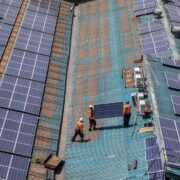
(Ecofin Agency) – Most commodity prices are expected to decline sharply this year amid sluggish global economic growth. But gas, oil, coal, and food prices will remain above their average 2015-2019 levels.
With few exceptions, the prices of energy products, fertilizers, metals, and agricultural commodities are expected to decline in 2023 and remain largely stable in 2024, the World Bank (WB) estimated in its Commodity Markets Outlook released on April 27.
The report estimates that global commodity prices could fall by 21% year-on-year in 2023, recording the largest decline since the coronavirus pandemic. Energy prices are expected to fall by 26% this year. The price of crude oil (Brent) is expected to average $84 per barrel this year, down 16% from the 2022 average, before rising 2.4% in 2024. Despite this decline, oil prices will remain higher than their 2015-2019 average, which was $57 per barrel.
In Europe and the United States, the price of natural gas is expected to be cut by half mainly due to declining demand in those two regions, which are increasingly relying on renewable energies to generate electricity. Nevertheless, the prices will remain almost three times higher than the average levels observed between 2015 and 2019.
Average coal prices are expected to fall from $350/mt (metric ton) in 2022 to $200/mt in 2023 and $155/mt in 2024, due in part to falling demand for this polluting fossil fuel, amid falling natural gas prices and rising carbon prices in Europe. Coal prices will nevertheless remain well above the average levels recorded during the five years preceding the coronavirus pandemic (2015- 2019).
37% drop in the price of fertilizers
The World Bank also expects fertilizer prices to fall by 37% in 2023, which would be the largest one-year decline since 1974. The largest declines in fertilizer prices will be for urea, potassium chloride, and ammonium phosphate (DAP).
Despite their sharp decline, fertilizer prices will remain close to the record level reached during the 2008-2009 food crisis.
The World Bank report also reveals that food prices are expected to fall by 8% this year and 3% in 2024, assuming that exports of grains and oilseeds from the Black Sea region remain stable. Wheat and corn prices are expected to decline by 17% and 15% respectively this year, thanks in part to reduced global demand and better-than-expected harvests in Brazil, Australia, Canada, Kazakhstan, and Russia.
However, rice prices are expected to rise by 17% in 2023, to $510 per ton, before dropping to $490 per ton, thanks in particular to the recovery of Pakistani exports.
As for coffee, Arabica prices are expected to fall by 14% this year and by 4% in 2024, while Robusta prices will remain almost stable compared to last year. Cocoa prices are expected to increase by about 13% in 2023 before declining slightly in 2024.
The World Bank notes that the decline in food prices is unlikely to provide much relief to the approximately 350 million food-insecure people around the world. Although food prices are expected to decline this year, they will remain at a record high that has only been exceeded once since 1975.
Precious metals will become safe havens again
The report also indicates that metal prices are expected to decline in 2023 and 2024, thanks to improved supply and a deteriorating global growth outlook. Double-digit declines will occur for aluminum, nickel, zinc, and tin. Iron ore, lead, and copper will experience smaller price declines.
Meanwhile, gold, silver, and platinum prices are expected to rise at rates ranging from 4% to 6% this year, due to strong demand from investors who once again see them as a safe haven in these uncertain economic times.
Gold and silver prices are expected to decline slightly in 2024 as inflationary pressures are expected to ease, while platinum prices will continue to rise.










Comments